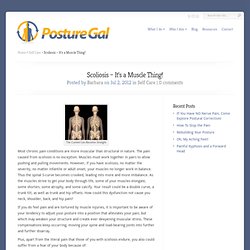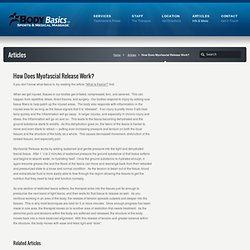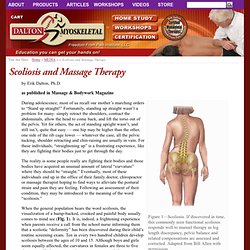

Scoliosis – It’s a Muscle Thing! The Curved Can Become Straight Most chronic pain conditions are more muscular than structural in nature.

The pain caused from scoliosis is no exception. Muscles must work together in pairs to allow pushing and pulling movements. However, if you have scoliosis, no matter the severity, no matter infantile or adult onset, your muscles no longer work in balance. Thus the spinal S-curve becomes crooked, leading into more and more imbalance. If you do feel pain and are tortured by muscle injuries, it is important to be aware of your tendency to adjust your posture into a position that alleviates your pain, but which may weaken your structure and create ever deepening muscular stress.
Plus, apart from the literal pain that those of you with scoliosis endure, you also could suffer from a fear of your body because of: The potential of surgery A worsening during pregnancy and menopause A lifetime of problems due to the eventual progression You owe it to yourself to try The Egoscue Method. Body Basics Sports & Medical Massage. If you don’t know what fascia is, try reading the article “What Is Fascia?”

First. When we get injured, tissues in our bodies get irritated, compressed, torn, and severed. This can happen from repetitive stress, direct trauma, and surgery. Our bodies respond to injury by adding scar tissue fibers to help patch up the injured areas. The body also responds with inflammation in the injured area for as long as the tissue signals that it is “stressed”. Myofascial Release works by adding sustained and gentle pressure into the tight and dehydrated fascial tissue. As one section of restricted fascia softens, the therapist sinks into the tissues just far enough to pressurize the next band of tight fascia, and then waits for that tissue to release as well. Share. Scoliosis and Massage Therapy. By Erik Dalton, Ph.D. as published in Massage & Bodywork Magazine Figure 1—Scoliosis.

If discovered in time, this commonly seen functional scoliosis responds well to manuel therapy as leg length discrepancy, pelvic balance and related compensations are assessed and corrected. Adapted from Bill Allen with permission. During adolescence, most of us recall our mother’s marching orders to “Stand up straight!” The reality is some people really are fighting their bodies and those bodies have acquired an unusual amount of lateral “curvature” where they should be “straight.” When the general population hears the word scoliosis, the visualization of a hump-backed, crooked and painful body usually comes to mind see (Fig. 1).
Fortunately, scoliosis takes many forms and need not always fall into a frightful medical category. Schroth Method - Exercises for Scoliosis. Caveat: It is very important for the patient or therapist to determine whether particular exercises described on this page, and in the book, are appropriate for the condition of a given patient.

The exercises depicted here in Sophie's example are for a three-curve, right-thoracic scoliosis, approximately corresponding to Fig. 113 in the book and the drawing on the web page "About the Method. " They cannot be adopted without alteration for a four-curve scoliosis, for instance, because in that case other static relationships are at work. See Part B, sections IV and VI of the book, which summarize the physical corrections necessary for three- and four-curve scolioses. A few different exercises performed by one patient may help readers to visualize how Schroth exercises are applied in an individual case of scoliosis. A central Schroth concept of exercise is to reverse malposture by striving for the opposite of the defective form that the scoliotic body has assumed.
Reversing Scoliosis. I’m sure this stuff is different for everyone.

Scoliosis is one of those weird things where people don’t know where in the world it comes from, and how or if you can get rid of it. If I had gone to see a doctor for my problem, he probably would have said it is too late for me at my age to consider surgery (his only solution) and that I would live out the rest of my days with my body slowly collapsing on itself. This wasn’t really an option for me. These are things that have helped me in particular and may also help someone that has chronic back pain that doesn’t have scoliosis: Isometrics Whether I’m sitting at my computer or walking around somewhere, I try to keep my abdominal muscles flexed as much as I can.
Swedish Exercise Ball Those big silver or colored balls that you see people in the gym laying across or exercising on. Inversion Table I picked up one of these off amazon after trying one out in a local Relax the Back store. Children's - Orthopaedic Institute - Scoliosis Exercises.